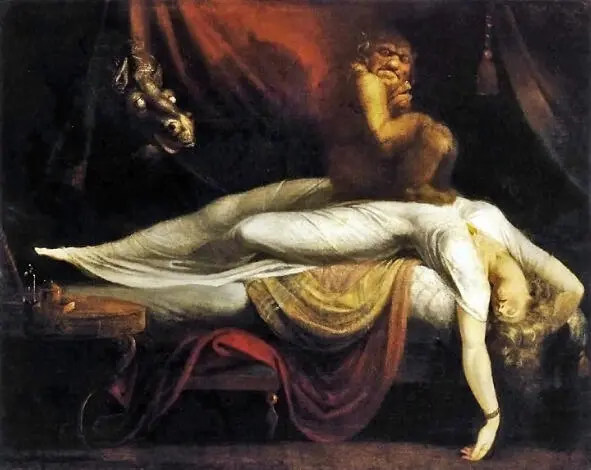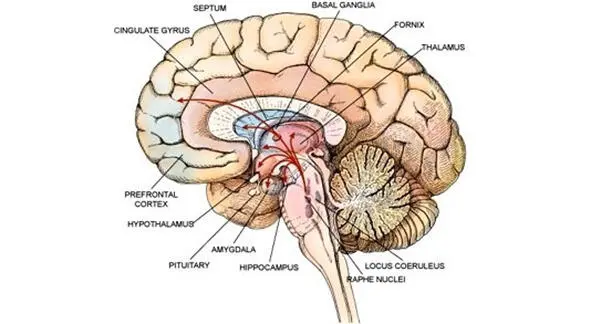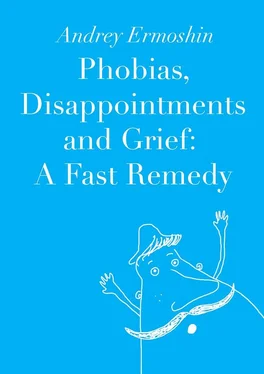There have been cases when people froze as if they were dead when meeting a bear, and the bear walked away.
We can see the similar reaction in the painting “The Nightmare” by Johann Heinrich Füssli (1741—1825). Fear is sitting on the stomach, while the mind is “switched off”.
Such reaction can be justified at the moment of danger but the problem is that the person remains in this state even after the danger has passed. The body seems to find it hard to return from the extreme mode to a normal state.

Fig. 2.J.H. Füssli. The Nightmare. 1790.
Psychocatalysis helps in the case of phobias
The techniques which help set oneself free from phobias and other psychological traumas have been developed within the frames of my original methodology called Psychocatalysis. Psychocatalysis is a method of focusing the attention of a person on the processes that get stuck, with the intent of restoring these processes back to normal functionality. Our ability to trace the signals in our internal space is the foundation of our self-regulation. This ability can serve not only for diagnostics but also as a way to introduce changes. When the conscious attention of a person helps the profound wisdom of a body , even long-lasting fears can be cured within a short period of time. Now let’s take a closer look at how phobias are formed and what one should do to get rid of them quickly and easily.
A well-rested healthy person feels that his or her body is light and cool, there’s the feeling of calm in the chest, and his or her head is clear. It is as if the person was filled with light. Energy of the body is flowing freely, and the mind is calm. In a state like that a person is absolutely aware of the fact where he or she is and what is happening. This person knows what to do next. The inner self at the level of the solar plexus is guiding this person through life. Reason at the level of the forehead helps the person. At the level of the chest there’s a firm and calm sensation. These are the three states of the completeness which save the person: the completeness of the mind, soul and will. Clarity, calmness and strength. I think this state is what we can find in the painting by Zinaida Serebriakova (1884—1967). Every person tries to maintain this state, but it doesn’t always happen.

Fig. 3.Z. Serebriakova. A Girl with the Candle. Self-portrait, 1911.
The beginning of neurosis
The metro trains in Moscow never come to a halt in the tunnel, but this time the train has stopped in the tunnel and it is not moving. One can simply wait for this episode to end, especially taking into account that there are people in charge of restoring a regular train service. One can simply continue reading a book or watching a film, listening to music or simply looking at the surrounding people and thinking his or her thoughts. This is exactly what most people do: they exchange opinions and interpretations on what’s going on and make some assumptions, all while remaining calm.
However, a person who is not used to the metro might think that the train will remain like that forever and there won’t be enough oxygen for everyone underground. Even though oxygen is not a problem, as the systems for oxygen supply are well thought through. Anyway the mind of such a person quickly pictures something really pessimistic.
What is happening at the level of the brain at this moment? Following some misleading ideas and fantasies our mind makes false assumptions and assesses the situation as an emergency. The cerebral cortex “freezes”, and the signal is sent deep down into the body where ancient evolutionary mechanisms spring to action. As a result, instead of sensibly doing something useful, a person suffers an autonomic storm. Moreover, once activated, this reaction will not turn off automatically.
This is what sets the beginning of neurosis. Most likely this person will not be able to enter a metro station again.
The Human being is a multilevel person
Our nervous system (NS) consists of mutually supporting elements which were developed at the different stages of the evolution. There are basic levels which unite us with much more ancient forms of life; there are also superstructural elements which are relatively newer from the evolutionary point of view: they are the unique patrimony of a human being.

Fig. 4.Neocortex is a “human brain”; limbic system is our “animal brain”, and our “reptile, or lizard brain” is located in the brain stem. In this figure you can see several elements of the limbic system: thalamus, hypothalamus, amygdala, hippocampus, and a basal gland, all of which take part in the way our body reacts to any incoming message.
“Reptile level” is our brainstem: this is what unites us with dinosaurs, turtles, and crocodiles. “Animal level” is our limbic system, which we share with cats and dogs. Finally, there is the human brain, per se; it is called the neocortex, and it is what makes us unique. All of these elements coexist within our nervous system. Of course, such a division is only relative since dinosaurs also had a cortex. However, the cortex plays a far more important role in the life of a human being. To a large extent evolution can be viewed as “embraination”, or cephalization, as it was noted by a famous philosopher Pierre Teilhard de Chardin (1881 – 1955).
Nevertheless, there is a more primeval nervous system; it is autonomous, and it is also referred to as “autonomic” which is represented throughout the body with ganglia, which look like “beads” along the spinal column (for instance, in the solar plexus) and even in some organs like our heart. One could observe the following principle: the lower we move down our body, the older the structures we encounter there.
There are several elements of our body which we share with annelid worms and even with hydras.
Our tender cortex
The cerebral cortex requires very delicate conditions to do its work. It is a well-known fact that it has little resistance to various injurious effects such as oxygen deficiency or the poisoning influence of ethanol. If the brain remains without oxygen for 5—7 minutes, its cells begin to die. In case of alcohol intoxication, the cortex starts deteriorating. However, the subcortex is much more resistant to harmful influence. The spinal medulla can remain up to 24 minutes without oxygen, while ganglia of the autonomous nervous system continue functioning without nutrition for many hours.
Emergency situations disturb the fine-tuning of the mind and take it to the realm of ancient survival instincts. When our intellect finds itself in a critical situation and it cannot find any optimal way of reacting to it, it “forwards” this task to the older structures of our mind. It is the place where our mind stores survival experience gathered from millions of years of evolution and this is what may lead to the altered state of mind.
Fright and primitive instincts
Читать дальше















